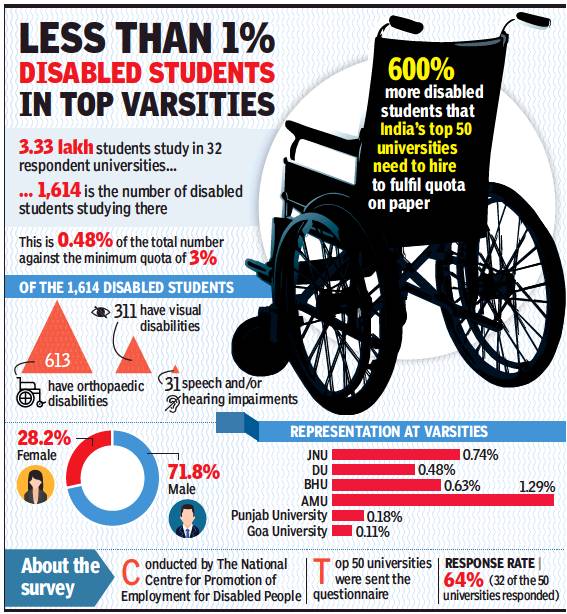Disabled people, disability laws: India
This is a collection of articles archived for the excellence of their content. |
Contents |
Disability in the Indian population
As in 2018
Nov 23, 2019: The Economic Times
NEW DELHI: Overall percentage of persons with disability in the population was 2.2 per cent during July 2018 to December 2018 in the country, showed a National Statistical Office (NSO) survey report on Saturday.
The NSO, a wing of the Ministry of Statistics and Programme Implementation, has conducted a Survey of Persons with Disabilities during July 2018 to December 2018 as a part of 76th round of National Sample Survey (NSS).
Prior to this, the survey on the same subject was carried out by the NSO during the 58th round (July-December 2002).
"In India, prevalence of disability (percentage of persons with disability in the population) was 2.2 per cent - with 2.3 per cent in rural and 2 per cent in urban areas. Prevalence of disability was higher among males than females," it said.
Among males, prevalence of disability was 2.4 per cent, while it was 1.9 per cent among females, it added.
The main objective of the survey was to estimate indicators of incidence and prevalence of disability, cause, age at onset, facilities available to the persons with disability, difficulties faced by them in accessing/using public building/public transport, arrangement of regular care giver, out-of pocket expenses relating to disability, etc.
The present survey covered 1.18 lakh households across India.
The survey said among persons with disabilities of age 7 years and above, 52.2 per cent were literate.
"Among persons with disabilities of age 15 years and above, 19.3 per cent had highest educational level as secondary and above. Among persons with disabilities of age 3 to 35 years, 10.1 per cent attended pre-school intervention programme. Percentage of persons with disabilities of age 3 to 35 years, who were ever enrolled in ordinary school, was 62.9 per cent," it said.
Percentage of persons with disabilities living alone was 3.7 per cent, while 62.1 per cent had care giver. About 21.8 per cent had received aid/help from government, and another 1.8 per cent had received aid/help from organisations other than government.
About 28.8 per cent reported that they had a certificate of disability.
Among persons with disabilities of age 15 years and above, Labour Force Participation Rate in usual status (ps+ss) was 23.8 per cent, the survey said adding that for thise aged 15 years and above, it was 22.8 per cent.
"Among persons with disabilities of age 15 years and above, Unemployment Rate in usual status (ps+ss) was 4.2 per cent," it added.
Disability Act, 1995
‘84% seats for disabled unfilled at top universities’
Manash Gohain, ‘84% seats for disabled unfilled at top univs’, November 30, 2017: The Times of India

From: Manash Gohain, ‘84% seats for disabled unfilled at top univs’, November 30, 2017: The Times of India
Thirty-two of India’s top universities and institutions of higher learning, including IITs, IIMs, Jawaharlal Nehru University and Delhi University, have together filled up barely 16% of the minimum quota for people with disabilities, a survey has revealed.
Exposing the appalling failure of the government in implementing the 1995 Disability Act — which fixed a minimum 3% quota — the National Centre for Promotion of Employment for Disabled People (NCPEDP) found that these institutions had just 1,614 disabled people out of a student population of 3.33 lakh, which is just 0.48% of the total.
Worse, women with disabilities constituted a mere 28% of the disabled students in these institutions, the survey found. Laws and policies are meaningless if colleges and universities are not accessible to persons with disabilities, said Javed Abidi, honorary director of NCPEDP.
Little to show on education 20 yrs after disability Act came into force
These are the top 50 national institutions. Imagine what it would be like in other colleges and universities across India,” he said.
Abidi said since the state of education was so bad, “obviously the employment rate of people with disabilities gets affected. There is hardly any supply chain.”
NCPEDP conducted the survey from August to November 2017, beginning with attempts to source data on representation of students with disabilities in India’s campuses. Some the of other institutions covered were University of Hyderabad, Benaras Hindu University, Aligarh Muslim University, Punjab University and Goa University.
It found that of the disabled students, 71.8% were male while 28.19% were female. NCPEDP has been pointing out for a long time that girls with disabilities were doubly disadvantaged.
“When I look at this ratio, I wonder what the HRD and women and child development ministries are doing about girls with disabilities. We have completely neglected the responsibility of educating people with disabilities. More than 20 years after the 1995 Disability Act, what do we have to show? The state of education is the same. In fact, it has gotten worse, as the survey helps expose.”
The study found that of the 1,614 disabled students studying in various universities, 613 have orthopaedic disabilities while 311have visual disabilities. Another 31 have speech and/or hearing impairments. For the survey, conducted by the National Centre for Promotion of Employment for Disabled People, the, top 50 universities were sent the questionnaire.
The reesponse rate was 64% ( that is, 32 of the 50 universities who were approached responded).